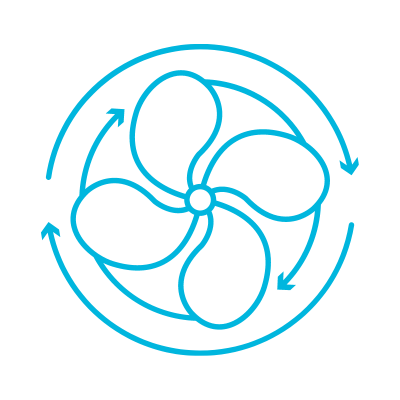
DATA CENTRE TERMINOLOGY
Key Server Room Terms
The language used when talking about server rooms and data centres can sound complicated. If you’re looking to brush up on the key terminology around data centre infrastructure, keep reading our detailed guide below.
A
Amp = Ampere (A, amp) is a unit used to measure electrical currents. One amp is the current produced by one volt passing through one ohm of resistance.
AC = Alternating current is the designation given to power that is delivered in the form of a sinusoidal waveform. AC won out over DC as the preferred method of delivering and using power in the industrial age due to the ease of voltage transformation using static devices (transformers).
ACAE = Air conditioning airflow efficiency is the amount of heat removed per standard cubic foot of airflow per minute.
AHU = Air handling unit.
B
Battery = Two or more cells are electrically connected to achieve the needed operating voltage and current levels to power hardware in the server room.
Biometric Access = Increase security with biometric access systems that only provide access to staff once they have passed facial recognition, fingerprint scans, and retinal scans systems.
Bypass Airflow = A conditioned air leak is known as bypass airflow and prevents adequately conditioned air from reaching specified computer parts.

C
Cold Aisle = An aisle where rack fronts face into the aisle chilled airflow is directed into this aisle so that it can then enter the fronts of the racks in a highly efficient manner.
Containment = A physical barrier between a hot and cold aisle using either long curtains or rigid plastic.
CRAC = Computer room air conditioner (pronounced crack) which uses refrigerant and a compressor cooling of the air in the data centre is accomplished by airflow over the evaporator coils where the refrigerant is being “directly expanded”.

D
DC = Direct current is a non-time varying method of delivering power. While slightly more efficient than AC if utilised between the DC portion of the UPS and the power supplies in IT equipment, it has not won wide acceptance in modern data centres.
DCIE = Data centre infrastructure efficiency is an efficiency measure that is calculated by dividing the IT equipment power consumption by the power consumption of the entire data centre. This measurement is the inverse of PUE.
Dew Point = The temperature at which air reaches water vapour saturation. Dew point is constant for a specific amount of water in a specific amount of air while relative humidity varies with temperature. The latest ASHRAE spec for data centre environmental conditions includes an upper limit for humidity based on dew point.
E
Economisation = Using the local environment around the data centre as part of the cooling strategy to reduce the temperature of the IT load.
EPO = A way of disconnecting the power required to operate the server room in case of an emergency.
Emergency Power System = If the power systems fail, this generator acts as a backup for hardware across the server room.
F
F = Fahrenheit is a unit of measurement for temperature.
Fault Current = When a short-circuit condition occurs, a fault current flows through the system.
Fluid Cooler = Coils and fans which are used to transfer energy in the form of heat to the outside environment.

H
Hot Aisle = An aisle where rack backs face into the aisle. Heated exhaust air from the equipment in the racks enters this aisle and is then directed to the CRAC return vents.
HVAC = Heating, ventilation, and air conditioning system. The set of components used to condition interior air including heating and cooling equipment as well as ducting and related airflow devices.
I
In-Row Cooling = Cooling systems installed between racks in a row that draws warm air from the hot aisle and delivers cool air to the cold aisle, minimising the path of the air.

K
kW = Kilowatts, one thousand watts. kWh = Kilowatt-Hour, one thousand watt hours. kWh is a common unit of electrical energy.
kVA = Kilovolt amperes = voltage x current (amperage).
KVM = Keyboard, video, mouse is an interface technology that enables users to access multiple servers remotely from one or more KVM sites. More obscurely, it can also mean Kernel-based Virtual Machine: a version of the Java Virtual Machine for small devices with limited memory.
M
MW = Megawatt is a measure of power equal to one million watts. Often used to describe the size of data centres in terms of power capacity.

N
N+1 = Need plus one is a redundancy concept where capacity is configured to include used capacity plus one additional device to enable continued operations with the failure of one system in the configuration.
P
PDU = Power Distribution Unit This typically refers to one of two pieces of equipment in the power delivery chain. One is the combination transformer/breaker panel that is often used between a UPS supplying voltage higher than that used by the IT equipment and the cabinets. The other is the smaller “power strip” like device that is used inside the rack to distribute power to the IT equipment.

PH = Phase is a term that describes the relationship between multiple time-varying waveforms that have a constant frequency but differ in their position relative to time. It is also used to refer to the number of sinusoidal voltages that make up the power delivery to a device. The most common are three-phase and single-phase. Single-phase consists of 2 conductors between which a sinusoidal voltage is present. Three-phase is a set of 3 or 4 conductors. In the case of 3 conductors, a sinusoidal voltage of a constant magnitude and frequency but a differing relationship concerning time exists between any 2 conductors. In a 4 wire system, the same voltage as in the 3 wire case exists between any of the three “hot” conductors, and in addition, between any of the three “hot” conductors and the fourth neutral conductor, there exists a voltage that is smaller by a factor of the square root of three than the voltage between any of the “hot” conductors.

PUE = Power usage effectiveness is a metric defined by the Green Grid and is a measure of data centre efficiency calculated by dividing the total data centre energy consumption by the energy consumption of the IT computing equipment.
U
U = A unit of space in a rack, equal to 1.75″ The vertical dimension of racks and IT equipment is often specified in “Us” such as 42U.
UPS = Uninterruptible power supply is a device placed in series with the supply of power from the utility which contains energy storage such that the supply of power from the UPS is continuous even when the utility supply is removed. While battery-based energy storage is the most common, flywheel-based energy storage is gaining in popularity due to the reduced maintenance cost.
V
V = Volt A unit of electrical potential.

Find out what makes our data centre design, build, construction and maintenance services different to our competitors.








